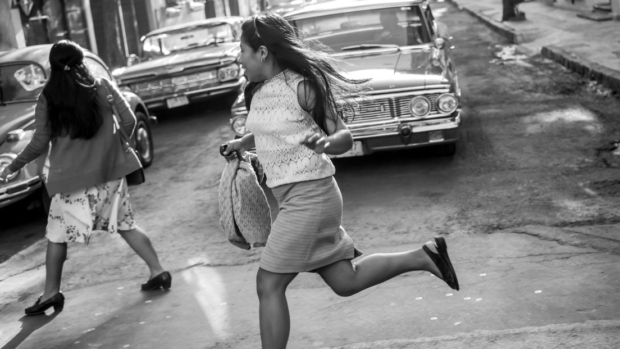 The story of a servant for a well-off Mexican family in the 1970s, told through a unique style that lends an epic quality to the main character’s everyday life.
The story of a servant for a well-off Mexican family in the 1970s, told through a unique style that lends an epic quality to the main character’s everyday life.
I just saw a masterpiece.
I don’t get to say that too often, at least not about new films. What I just saw is Roma, the latest movie written and directed by Alfonso Cuarón. The title, Roma, refers to the name of a middle class neighborhood in Mexico City in which Cuarón grew up—the picture is in many ways autobiographical. The story follows an upper middle class family—parents, four children, and grandmother—through one tumultuous year from 1970 to ’71. But the point of view character, through which we experience the story, isn’t a member of the family, not by blood—it’s their live-in servant and nanny, a young woman named Cleo, played by Yalitza Aparicio.
The film opens with her hard at work, cleaning the large house before the arrival of the rest of the family from an outing. As the film goes on, we observe her interactions with the family, fetching whatever they need, getting the kids clothed and off to school, even singing to them when they go to bed. In some ways she is as intimate with the kids, or maybe even more so, than their mother. But we also can’t help but notice Cleo’s status as an outsider. The family is light-skinned; she is dark. She speaks Spanish like them, but being ethnically indigenous, we also hear her talking with her friend, the cook Adela who also lives there, in an Indian dialect. And of course, there is the difference in class, between affluent and working poor. For the most part, she is treated affectionately as a part of the family, even loved. At certain moments, however, the gulf will be revealed through insult, rebuke, or cruel and insensitive comments. And the core of her identity is experienced through its absence—her family, her village, her origins are only hinted at with occasional comments and asides. She had to leave all that, but she does have her own life, separate from her life as a servant, and one aspect, involving a boyfriend, ends up complicating things.
I’m deliberately revealing as little as I can about the story, because I don’t want you to miss the subtle experience of revelation that is part of watching Roma. In fact, the style of the film presents the story in a way that evokes a strong sense of the moment rather than the usual one-thing-after-another approach. In addition to writing and directing the film, Cuarón was his own cinematographer, and he employs a lot of wide shots, both in large interior spaces and outdoors, in which the camera tracks through the screen space inside of which the characters move, talk, and interact. The impression is of a vibrant, living reality, not the edited series of linear shots we’re accustomed to. The movie is in black and white; the photography is incredibly beautiful, but in addition the choice of black and white somehow creates the sense that you are really there in the past, in the early 70s, experiencing all this. There’s no musical score. The only music you hear is what they call “diegetic” music: music that characters in the film hear on the radio or play on records and so forth. So on top of the brilliant sophisticated visual style, you have a sound design that is completely naturalistic.
Another thing that struck me is that the children, ranging from what looks like maybe 13 to 8 years old, act like real children. Their talking and bickering, and the way they resist parental control, are absolutely what real kids sound like. It’s as if we’re just eavesdropping on them.
All these formal aspects and techniques are not there just for their own sake. They’re part of a graceful and refined vehicle for a moving story of one lonely character—a woman who loves and suffers, remains essentially separate from the privileged environment in which she’s been placed, but in whom we are allowed to glimpse a heroic nature. Aparicio, a newcomer to film, is miraculous in this central role of Cleo. The rest of the cast, many of whom are also new to the screen, is impeccable.
Finally, the best way to see Roma is on the big screen. The staggering beauty of this picture is only fully realized in a theater. I urge you to watch it that way while you have the chance. I’m going back this week to see it again.

French director Mia Hansen-Løve has become one of my favorite filmmakers. Her stories about “ordinary” life and relationships, and her style, are so relaxed...

A mystery from Argentina becomes a meditation on love, art, and the agency of women. Trenque Lauquen, a film by Argentine director Laura Citarella,...

Ari Aster’s disturbing drama about a man (Joaquin Phoenix) who is afraid of everything all the time, bursts through the limits of the horror...